Executive Summary

The University of California celebrates its 150th anniversary this year. This milestone is an opportunity to reflect on UC’s rise from a small institution serving just 40 students in 1868 to its status today as one of the world’s great public research universities.
For this sesquicentennial edition of the Accountability Report, the original seal of the University, designed in 1884, and UC’s motto, can be seen not just as an inspiration for the mission of the University, but also as a metaphor for accountability: Let there be light.
The 2018 Accountability Report provides a unique lens for tracking that story through data. It shows where UC has been —and more importantly — the opportunities and challenges that lie ahead. As such, this year’s report highlights select points in UC’s history and the key indicators and trends that illuminate the status of UC operations for future reference.
A partnership to create the University of California
The story of UC is of a productive partnership between California and the University, one that illustrates how investments made by the state and its citizens produce outsized returns. It begins with Henry Durant who founded the College of California in Oakland. Durant donated land and the state provided funding to create UC, which moved to Berkeley in 1868. Lawmakers believed that their young state needed an educated populace to thrive, and so UC opened its doors to all, without regard to student income or background. That egalitarian spirit continues to this day.
Other UC campuses soon followed Berkeley. Hugh Toland established the Toland Medical School which in 1873 affiliated with the University of California and formed what later became UC San Francisco. UCLA and UC Santa Barbara began as teaching colleges that later converted to UC campuses.
In 1949 Governor Earl Warren signed legislation to authorize both UC Riverside, which started in 1907 as the UC Citrus Experiment Station, and UC Davis, which opened its doors in 1905 as the University Farm. Under Governor Pat Brown’s leadership in the 1960’s, UC Santa Cruz, UC San Diego (which included the Scripps Institution), and UC Irvine opened to help California accommodate a huge surge in college-bound baby boomers. UC Merced opened in 2005, becoming the first 21st century American academic research university.
Undergraduate and graduate student enrollment, with campus opening date
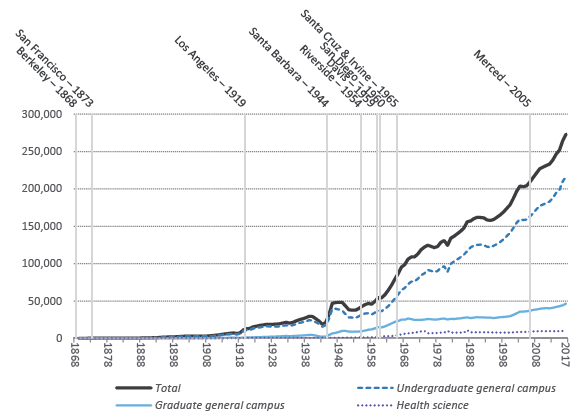
California’s investment in UC allowed the University to advance the state and its economy by:
- Attracting dollars and talent into the state
- Providing research to support existing industries and launch new ones
- Developing expertise and solutions for major public challenges
- Supplying most of the state’s advanced degrees including for key workforce areas
- Creating economic mobility for very large numbers of low-income students
- Serving public interest needs in education, health care, the environment, and other major service areas
Today, the University has over two million living alumni, operates California’s fourth largest health care delivery system, and serves as the third largest employer in the state.
A partnership to hire leading faculty to advance research
Under the California Master Plan for Higher Education, adopted in 1960, the state designated UC as the research arm of the state. The University’s already strong research enterprise was further accelerated by state investments in faculty hiring, allowing the University to attract top-tier researchers. Today UC’s research prowess is reflected in the numerous honors and awards earned by faculty, along with its ability to attract an outsized share of research funding. UC is the nation’s pre-eminent academic research system, performing nearly one-tenth of the nation’s academic research (9.2.2).
UC research is not limited to its ten campuses but spans the state including two National Energy Laboratories (one located outside California), five UC academic medical centers, and 39 natural reserves.
This investment has paid off: starting in the late 1800s, UC soil scientist Eugene Hilgard showed farmers how to remove salts from the alkali soils of the Central Valley, turning what was once barren land into one of the world’s most productive farming regions. He also helped California establish its wine industry. Today, UC’s Agriculture and Natural Resources Division brings the power of UC research and education to agricultural communities across California (10.1.1).
UC faculty receive many prestigious awards as leaders in their fields.
Faculty Honors and Awards (13.1.2)

UC discoveries advance industries including health care biotechnology, information technology, and clean energy. UC research yielded discoveries of vitamins E and K; vaccines for flu, hepatitis B, and polio prevention; and new treatments for cancer, AIDS, Alzheimer’s, and autism. UC surgeons performed California’s first heart transplant. UC medical centers currently conduct half of all organ transplants in California and treat one-quarter of extensive burn care cases in the state. Clinics run by UC Health have more than 750,000 outpatient visits a year. Nearly 60 percent of UC Health patients have Medicare or Medi-Cal, or have no insurance at all. (Chapter 11).
The University of California spends $4.5 billion on research, and the majority of these funds come from outside California (9.1.1). These funds create jobs and are spent on goods and services across the state that support research. UC research activity also spurs strong economic hubs around UC campuses.
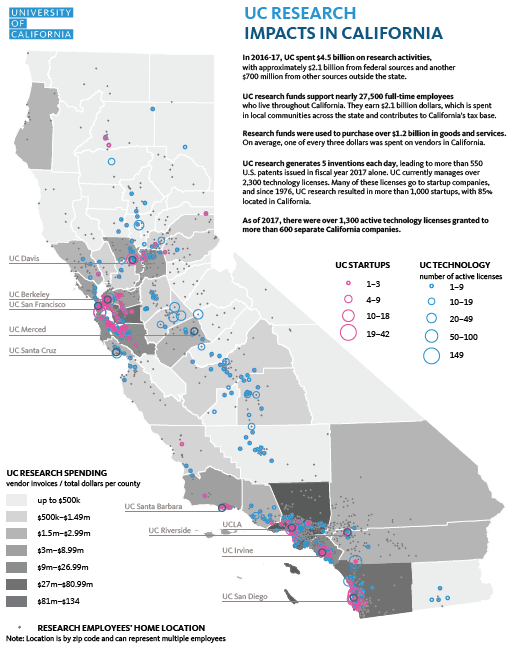
A partnership to advance graduate education to produce future researchers and promote industry needs
Under the California Master Plan for Higher Education, UC has exclusive authority within California’s public higher education partners to grant doctoral degrees (with a few exceptions) and to offer instruction in law, medicine, dentistry, and veterinary medicine. Half of UC’s Ph.D. and academic master’s degree graduates are ultimately employed in higher education – 25 percent of UC tenure and tenure-track faculty, and 21 percent of current California State University tenure and tenure-track faculty earned their doctorate from UC. Under UC faculty supervision, graduate students in academic programs create an average of almost 600 new inventions a year. Every two weeks, a startup is formed based on an invention created by a UC graduate student.
Half of UC Ph.D. & master’s graduates who stay in California work in higher education.
Industry of employment of UC graduate academic (top graph) and graduate professional (bottom graph) students in CA, by year after graduation (4.3.6 and 4.4.2), 2000 to 2014 graduating cohorts
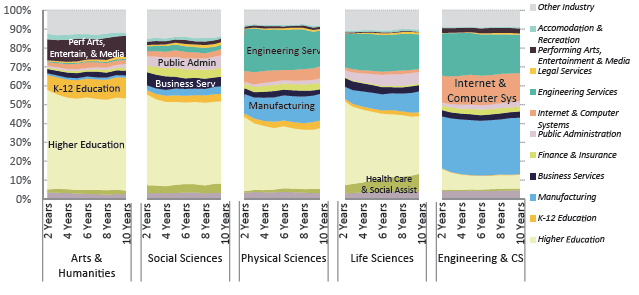

UC professional degree students go on to become business leaders, lawyers, and health care professionals. Nearly 15,000 students are enrolled in UC’s health science and residency programs, producing the next generation of caregivers for a state that will increasingly need greater numbers of health care professionals. Looking ahead at the state’s workforce needs, UC graduate students will play a key role in creating jobs and supporting industries that keep California strong.
A partnership to advance undergraduate opportunities, particularly the economic mobility of low-income students
In partnership with the state, UC has been particularly active in making undergraduate degrees affordable for low-income students. Between the Cal Grant program (state funded financial aid) and UC’s Blue and Gold financial aid program, 56 percent of UC undergraduates pay no tuition. Many also get help for non-tuition costs, i.e., housing, books, transportation, and other costs. The University of California provides unprecedented access to Pell Grant recipients, particularly when compared to other Association of American University (AAU) public and private peer institutions.
UC enrolls a higher percentage of Pell Grant recipients than any other top research university in the country.
Undergraduate Pell Grant recipients, UC and comparison institutions, 2015–16 (2.2.1)

While there is a graduation rate gap at year four between UC’s Pell Grant and non-Pell recipients, the two groups have comparable graduation rates at year six. Within five years of graduation 77 percent of low-income students earn more than their parents, reinforcing the New York Times’ characterization of UC as “California’s upward mobility machine.”
Engineering and computer science majors tend to earn more than other UC undergraduate alumni, but how much UC alumni make also depends on the industry of employment.
Median alumni wages by industry of work for selected majors, five years after graduation, 2000 to 2011 graduating cohorts, combined (3.3.5)
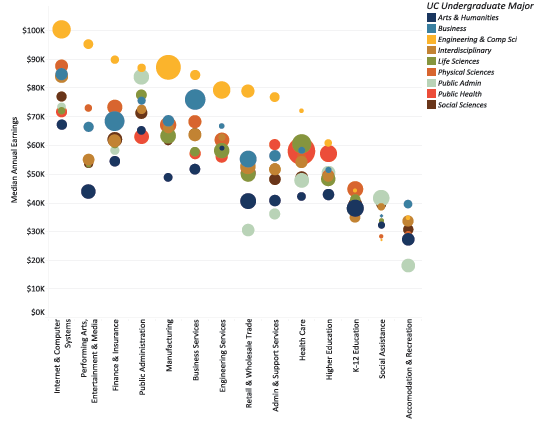
UC undergraduate degree recipients report significant growth in the skills that employers seek, demonstrating UC’s skill at preparing students for future careers. The National Association of Colleges and Employers cite the key attributes that employers seek: leadership, ability to work in a team, written communication skills, problem-solving skills, and verbal communication skills. Respondents to the UC Undergraduate Experience Survey (UCUES) cite significant positive gains in these areas, along with growth in their field of study.
Self-reported skill levels from first year to senior year for seniors who entered as freshmen, Spring 2016 (8.1.1)

As UC expands access to undergraduate education for low-income students, the University must also expand access to graduate education for these students. Almost 40 percent of UC undergraduates go on to graduate school, with African-American students doing so at an even higher rate. This trend is strong in key disciplines. Many go on to earn professional graduate degrees - business majors earn MBAs, Arts & Humanities and Social Science graduates earn law degrees. Many low-income students also go on to earn academic graduate degrees. UC is proud to note that its more diverse campuses – Merced, Riverside, and San Diego – are feeder schools to UC academic doctoral programs. Around 70 percent of UC Merced students who go on to get a Ph.D. do so at a UC campus.
A future partnership to help UC meet California’s needs
As California grapples with present and future challenges, the University of California continues to be a major partner in the state’s successes and strengths. UC’s faculty, research enterprise, and graduate students provide hope for future economic development and meaningful discoveries. For example, this year’s UC Grad Slam winner, Joseph Charbonnet of UC Berkeley, shown here, is studying a novel way to collect and clean stormwater to help the state address drought.

Over the next twenty years, the number of California baby boomers who are retiring will grow significantly, reducing the number of college educated workers in the state. UC’s internal projections are that the number of high school graduates will continue to grow, in part due to increasing high school graduation rates for Hispanic/Latino(a) students. UC has identified areas for improvement across the undergraduate degree pipeline, particularly improving the number of California high school students who complete their A-G coursework, which could boost college-going rates.
UC is not keeping pace with the ethnic diversity of California high school graduates, primarily due to differences in A-G course completion.
Racial/ethnic distribution of the UC undergraduate pipeline (7.1.1), Fall 2016 new freshman cohort from California public high schools
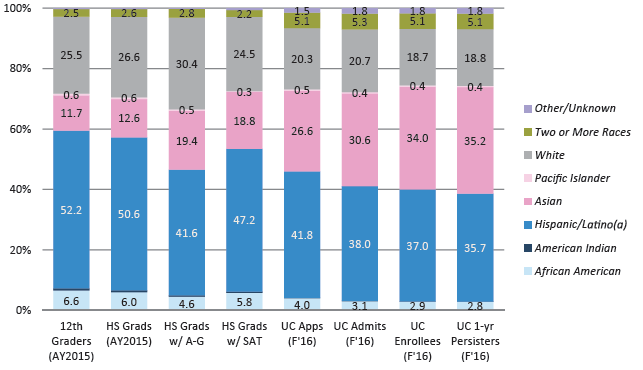
Sources: California Department of Education; College Board; UC Information Center Data Warehouse
UC is continuing its efforts to improve the transfer process, including the Academic Senate Transfer Pathways Project that led to a common set of lower-division course requirements for each of UC’s top 21 most popular majors among transfer applicants. UC is getting close to achieving its systemwide (excluding Merced) target of a 2:1 ratio for undergraduate enrollment: two new freshmen for every one transfer student (1.1.3). Five UC campuses have met this goal and the remaining three, excluding Merced, have plans to do so.
UC President Janet Napolitano and Chancellor Eloy Ortiz Oakley of the California Community College (CCC) system have signed an agreement to increase the number of academically prepared community college students who transfer to UC and earn a bachelor’s degree. Under the agreement, community college students who complete a transfer pathway and have the requisite GPA are guaranteed a place at UC, beginning in fall 2019. In addition to the UC-CCC agreement, UC has ramped up its outreach programs to high school and community college students to make sure they are prepared for UC and made aware of financial aid programs to attend.
UC programs improve academic skills of K–12 and community college students across California.
UC K–12 and community college student services programs, Spring 2017 (10.3.1)

Source: UC campuses
SAPEP (Student Academic Preparation and Educational Partnerships) outreach programs such as the Early Academic Outreach Program (EAOP), Mathema cs, Engineering, Science Achievement (MESA) and The Puente Project are designed to increase comple on of college preparatory (“a-g”) courses, support enrollment directly from high school into four-year institutions and support preparedness to transfer from community colleges to four-year institutions.
In 2015–16, SAPEP programs served nearly 160,000 K–12 students at more than 1,100 public schools, and over 25,000 community college students at all 113 community colleges. In addition, over 52,000 parents/guardians of K–12 students and over 13,000 teachers, counselors and school administrators also participated in SAPEP programs.
Providing access to UC is important, but it is equally important that students graduate and that they do so in a timely manner. The University of California is working to increase degree completion rates – President Napolitano recently stated the goal to increase four-year graduation rates to 70 percent. Achieving this goal will require a concerted effort to improve timely graduation of low-income and first generation students. As seen in the next chart, the most recent four-year graduation rate for Pell recipients is around 60 percent. Students often take four years and an additional term to graduate, which is why the 5 and 6 year rates are also shown.
Over 80 percent of Pell students graduate within six years.
Freshman graduation rates by Pell Grant recipient status, Cohorts entering fall 2011, 2012 and 2013 (3.1.6)
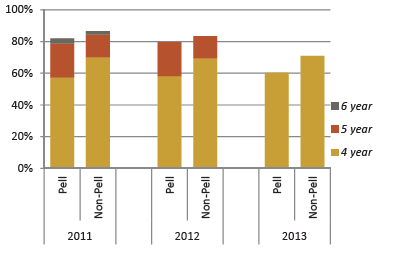
Source: UC Data Warehouse. Pell Grant recipients are those who received a Pell Grant at any time during their time at UC.
Strategies to improve graduation rates for Pell recipients will likely require additional investment, including expanded financial support for summer enrollment, enrollment in smaller courses, greater advising support, and other programs that improve outcomes, such as those that foster a sense of belonging to the institution for first-generation and underrepresented students. The student-faculty ratio continues to increase, however, and there is an uptick in large lower-division courses. These realities make improving time-to-degree more challenging.
The number of credit hours in courses with over 150 students continues to rise.
Student credit hours, by instructional staff and class type and class size, lower division classes (8.3.4)
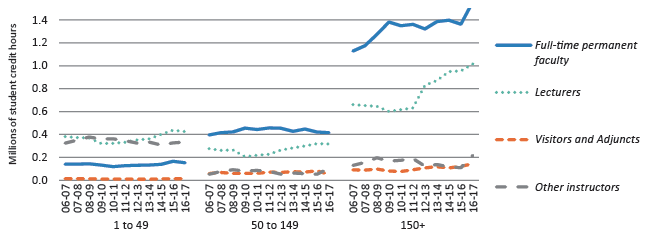
Since it was established, the trusted partnership between the State of California and UC has served generations of Californians: providing a better future, powering the economy, and lifting up all California residents. This partnership needs to be renewed and strengthened.
As in the past, investment by the State in the University of California leads to a strong return on investment and opens doors for California’s future generations. Ensuring a well-funded research enterprise establishes a strong foundation for California’s economy, from meeting social challenges to launching future industries. An investment in research is also an investment in UC’s graduate students who are the State’s future researchers, educators, and job creators. Adequate support for the growth in undergraduate enrollment advances economic mobility for the entire State.
A hallmark of UC’s partnership with the state is the University’s commitment to improving its operations and to making the most of its resources. The Accountability Report is an essential tool for both of those goals. UC uses the data in the Accountability Report and in the UC Information Center to track performance across the system and address areas that need improvement. As one example, the attached Executive Summary Accountability Report dashboard mirrors similar campus dashboards used in annual budget meetings between the President and Chancellors to discuss progress, challenges, and improvement goals.